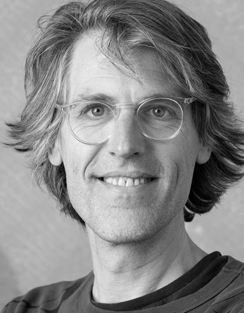Knowledge journal / Edition 2 / 2020
Water quality: from agricultural ditches to regional surface waters
For the European Water Framework Directive (WFD), ecological water quality is monitored in surface waters that are managed by the water boards and the national government, but not in the ditches on farms. How do the total concentrations of nitrogen (N) and phosphorus (P) in these ditches relate to those in regional surface waters? Does this differ between soil type regions? And, does the ratio of the components that together form total N and P differ? New (summertime) measurements taken of the ditches enable this comparison.
The European Water Framework Directive aims to achieve good chemical and ecological quality of all waters throughout Europe. To monitor ecological water quality, the concentrations of N and P are important parameters. Surface water quality is monitored in several (national) monitoring networks: the WFD monitoring networks, the Agricultural-specific Surface Water Monitoring Network (Meetnet Landbouw Specifiek Oppervlaktewater, MNLSO) and the Minerals Policy Monitoring Programme (Landelijk Meetnet effecten Mestbeleid, LMM). These monitoring networks have been set up for different purposes. The WFD monitoring networks have been set up to test WFD water bodies against chemical and ecological WFD standards. The MNLSO monitors the quality of regional surface waters that are mainly affected by agriculture. The water boards monitor the regional WFD water bodies and the MNLSO locations; these overlap in some cases. The LMM has been set up for the monitoring of the Nitrates Directive and focuses, among other things, on leaching and run-off of nutrients (mainly N and P) to ditches on farms.
In terms of scale, these monitoring networks are linked to each other (Figure 1). The LMM measures the direct influence from agricultural parcels. The MNLSO locations were chosen in such a way they do not contain point sources — such as a wastewater treatment plant; they are primarily fed with water from agricultural areas. The WFD water bodies are affected by both agricultural and point sources.
 Figure 1. Schematic representation of monitoring networks for surface water quality: the ditches on farms of the LMM, agriculture-specific waters of the MNLSO and the regional WFD water bodies (adapted from [4]).
Figure 1. Schematic representation of monitoring networks for surface water quality: the ditches on farms of the LMM, agriculture-specific waters of the MNLSO and the regional WFD water bodies (adapted from [4]).
The WFD targets for total nitrogen (N) and phosphorus (P), important for ecological water quality, are exceeded in approximately half of the WFD water bodies [1]. According to model calculations, this is largely the result of leaching and run-off of N and P from agricultural soils, which enter the regional surface waters via the agricultural ditches [2]. Leaching and run-off primarily occurs during the winter, when there is a precipitation surplus. The different monitoring networks show that during the winter the nitrate concentrations are highest in LMM-ditches and decrease subsequently in MNLSO and WFD waters [3].
However, the ecological WFD standards are expressed in summer averages for total N and P, as they are an important determinant of the nutrient richness of the water and the realisation of a good ecological water quality. The LMM traditionally measures agricultural ditches during the winter to monitor the leaching of nutrients. Since 2017, the LMM has also measured total N and P in agricultural ditches during the summer. With these new summer data, we investigated whether the wintertime leaching of nutrients from farms is reflected in higher summer concentrations of total N and P in LMM ditches compared to the MNLSO waters and the regional WFD waters.
Comparison method
To better align with the measurement strategies of the other monitoring networks, LMM has been measuring the concentrations of total N and P in agricultural ditches since 2017, three times during the period June-September, just like the water boards in unfiltered water (Table 1). The remaining differences in measurement strategies were taken into account in the data selection. Only data for the summer months in the years 2017-2019 were selected from the monthly data collected by the water boards. From these, average values were calculated per main soil type of the region (clay, peat and sand). The loess region was not included as it hardly contains any ditches. The water boards standardly collect water samples at a depth of 30 cm; the LMM samples the uppermost ditch water. The measurements have not been corrected for this difference.
 Table 1. Measurement strategies of the various monitoring networks (LMM, MNLSO and WFD)
Table 1. Measurement strategies of the various monitoring networks (LMM, MNLSO and WFD)
For both the LMM and MNLSO, we also looked at the various components that together form total N and P: nitrogen in nitrate (N-NO3), ammonium (N-NH4) and organic matter and phosphorus in orthophosphate (P-PO4) and phosphorus as (in-)organically bound. Nitrite (NO2) is not included because LMM does not measure nitrite, and it occurs in very low concentrations at the MNLSO and WFD locations. For all types of water, average summer concentrations of total N and P were compared to the WFD targets for freshwater-buffered ditches (M1a ditches): 2.4 mg N/l and 0.22 mg P/l. The WFD standards are derived per body of water depending on local conditions. Using a linear mixed model, differences in total N and P and the components between the various monitoring networks, regions and years were tested, with the measurement location designated as a random factor. Because three measurement years are insufficient for determining a trend, we looked at differences between the monitoring networks and regions over three measurement years combined (Figure 2).
 Figure 2. Average summer concentration (with standard error) of total nitrogen (A) and phosphorus (B) in agricultural ditches (LMM), agriculture-specific waters (MNLSO) and regional WFD waters per main soil type for the years 2017-2019. The grey lines indicate the WFD targets for total nitrogen and phosphorus of freshwater-buffered ditches.
Figure 2. Average summer concentration (with standard error) of total nitrogen (A) and phosphorus (B) in agricultural ditches (LMM), agriculture-specific waters (MNLSO) and regional WFD waters per main soil type for the years 2017-2019. The grey lines indicate the WFD targets for total nitrogen and phosphorus of freshwater-buffered ditches.
In the clay and sand region, total N and total P in the LMM ditches (all years combined) were significantly higher than at the MNLSO and WFD locations. In the peat region, all years combined, total N and P in the LMM ditches were not significantly different from the MNLSO locations, but were higher than the WFD locations. The MNLSO and WFD locations only differed in total P in the peat and play region. It is remarkable that during the (dry) summer of 2018, very high concentrations of total N were measured in the agricultural ditches in the sand region, and not (yet) in the other regions and monitoring networks.
Results for nitrogen and phosphorus components
 Figure 3. The summer average for nitrogen (A) and phosphorus (B) components of total N and P in agricultural ditches (LMM) and agriculture-specific waters (MNLSO) over the years 2017-2019 per soil type region. For the regional WFD waters, these data were not (yet) available in usable form.
Figure 3. The summer average for nitrogen (A) and phosphorus (B) components of total N and P in agricultural ditches (LMM) and agriculture-specific waters (MNLSO) over the years 2017-2019 per soil type region. For the regional WFD waters, these data were not (yet) available in usable form.
For total N and P in the clay and sand region, the LMM measures higher values than the MNLSO (Figure 2). Figure 3 illustrates that this is mainly due to high concentrations of organic-N and bound-P and not due to the inorganic nutrients (nitrate, ammonium and orthophosphate). The sum of the inorganic nitrogen components of ammonium and nitrate is comparable in all regions in both monitoring networks. The concentration of orthophosphate in the MNLSO is higher in all regions than in the ditches of the LMM.
Discussion
Comparing the new measurements of the summer values for total N and P in agricultural ditches with the (summer) measurements from regional surface waters creates a more complete picture of ecological water quality in the Netherlands at the various scales. The current total concentrations of N and P in agricultural ditches appear to be much higher than the WFD targets for freshwater-buffered ditches. For the clay and sand region, summer concentrations of total N and P in agricultural ditches are, as expected, higher than in the MNSLO and WFD surface waters (Figure 2). This is mainly due to organic-N and bound-P in agricultural ditches (Figure 3) and not to inorganic nutrients.
An important difference between the agricultural ditches and the more regional water bodies is the size of the waterways. Differences in the nutrient concentrations are related to this. Due to their shallow depths, agricultural ditches warm up faster during the summer. This is advantageous for algae growth, whereby inorganic nutrients are absorbed. Due to the shallow depths, the re-suspension of (organic) sediment particles could also play an important role in agricultural ditches. In addition, biochemical and dilution processes influence nutrient concentrations in the surface water system.
In the peat region, the total N and P in the LMM ditches do not differ significantly from the MNLSO waters. Particularly in the peat region, foreign (not from the region) water is allowed to enter many polders in summer to maintain a sufficiently high water level in the ditches, resulting in a mixture of ditch water and inlet water.
We would like to emphasise that the very dry summers of late have led to exceptional circumstances. The results presented here are for the years 2017-2019 and may differ from the average situation.
During the winter, leaching processes play an important role, as there is a precipitation surplus. Nitrogen and phosphorus in agricultural ditches in the winter can, therefore, be more clearly linked to leaching than during the summer. Moreover, the direction of the flow of water and nutrients during the winter is more unambiguous, namely from the parcels via the ditches to the bigger waters. To investigate the relationship between the leaching of nutrients in the winter and the development of N and P concentrations in the summer, the summer and winter measurements of all monitoring networks should be compared. This will require additional winter measurements of total N and P in the LMM ditches.
Jonas Schepens
(Rijksinstituut voor Volksgezondheid en Milieu (RIVM), LMM)
Saskia Lukács
(Rijksinstituut voor Volksgezondheid en Milieu (RIVM), LMM)
Arno Hooijboer
(Rijksinstituut voor Volksgezondheid en Milieu (RIVM), LMM)
Annemieke van der Wal
(Rijksinstituut voor Volksgezondheid en Milieu (RIVM), LMM)
Simon Buijs
(Deltares, MNLSO)
Summary
Measuring total nitrogen and phosphorus in both regional surface waters and agricultural ditches provides a more complete picture of ecological water quality in the Netherlands. In general, the summertime concentrations of total nitrogen and phosphorus in agricultural ditches are higher than in regional surface waters. Long-term monitoring should indicate whether additional attention and actions taken to reduce the (high) concentrations of total nitrogen and phosphorus in ditch water will lead to the fulfilment of the WFD targets.
References
Duijnhoven, N. van, Linden, A. van der, et al. (2019) KRW – Toestand- en trendanalyse voor nutriënten. Deltares, rapportnr. 11203728-006.
Groenendijk, P., Boekel, E.M.P.M. van, et al. (2016). Landbouw en de KRW-opgave voor nutriënten in regionale wateren. Wageningen Environmental Research, Rapport 2749.
Fraters, B., Hooijboer, A.E.J., et al. (2016). Agricultural practice and water quality in the Netherlands: status (2012-2014) and trend (1992-2014). RIVM, Report 2016-0019.
Klein, J., Rozemeijer, J., et al. (2016, 18 februari) Toestand en trend MNLSO- en KRW-meetlocaties. https://www.helpdeskwater.nl/publish/pages/131116/presentatie_deltares_mnlso_gap_20160218.pdf.
Auteurs

Jonas Schepens
(Rijksinstituut voor Volksgezondheid en Milieu (RIVM), LMM)

Saskia Lukács
(Rijksinstituut voor Volksgezondheid en Milieu (RIVM), LMM)

Arno Hooijboer
(Rijksinstituut voor Volksgezondheid en Milieu (RIVM), LMM)

Annemieke van der Wal
(Rijksinstituut voor Volksgezondheid en Milieu (RIVM), LMM)

Simon Buijs
(Deltares, MNLSO)








